Unit 4 Where's my schoolbag? Section A (2d-3b) 课件 (共30张PPT)
文档属性
| 名称 | Unit 4 Where's my schoolbag? Section A (2d-3b) 课件 (共30张PPT) |  | |
| 格式 | pptx | ||
| 文件大小 | 26.1MB | ||
| 资源类型 | 教案 | ||
| 版本资源 | 人教新目标(Go for it)版 | ||
| 科目 | 英语 | ||
| 更新时间 | 2022-11-01 12:57:51 | ||
图片预览

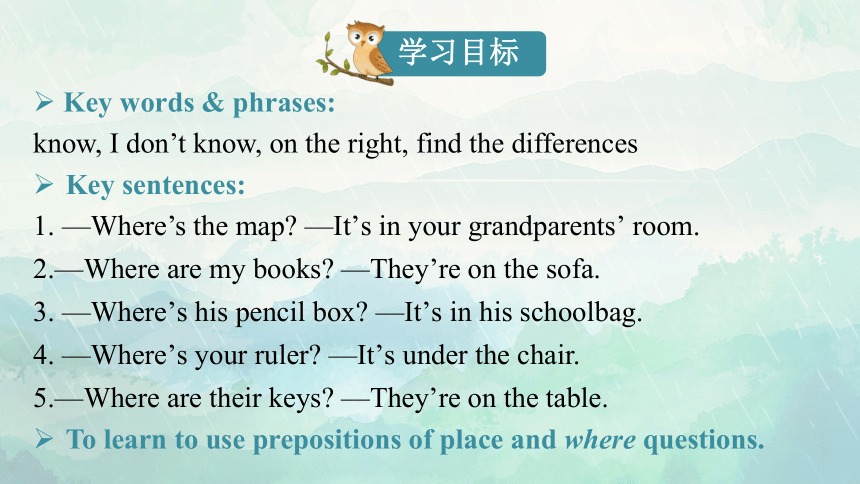
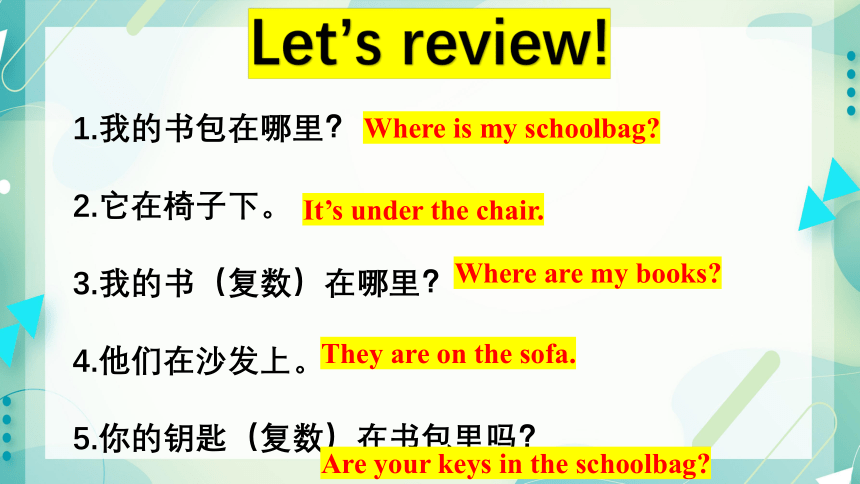
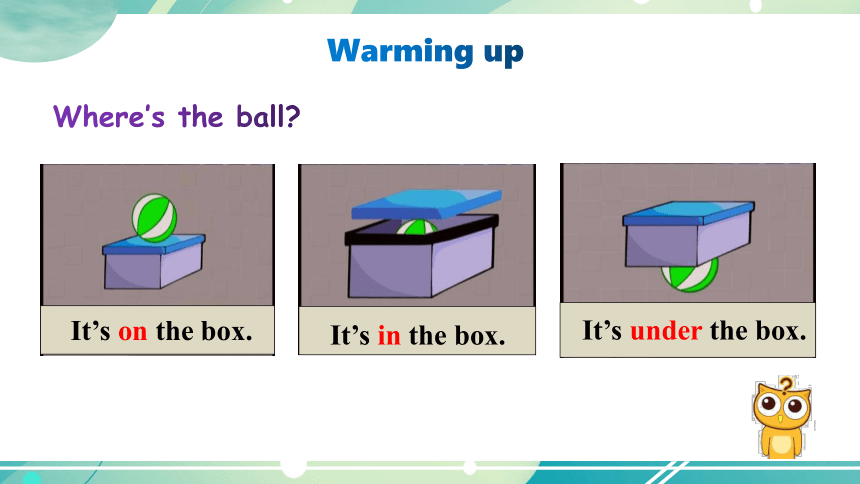
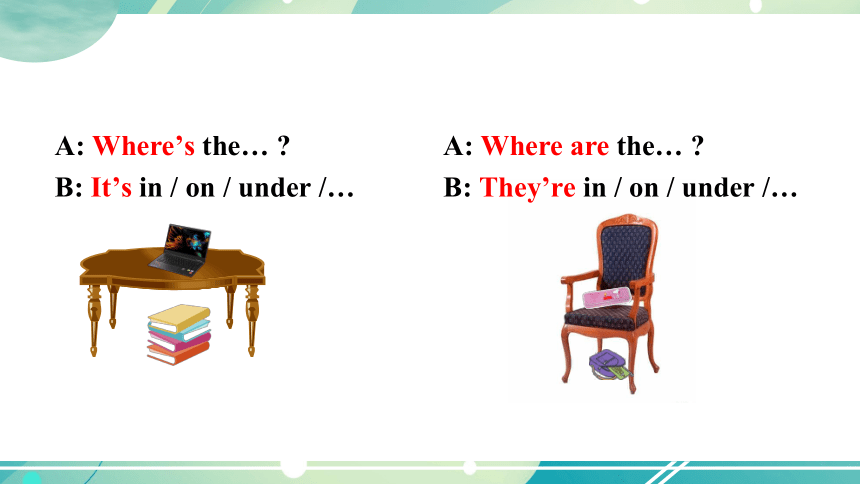
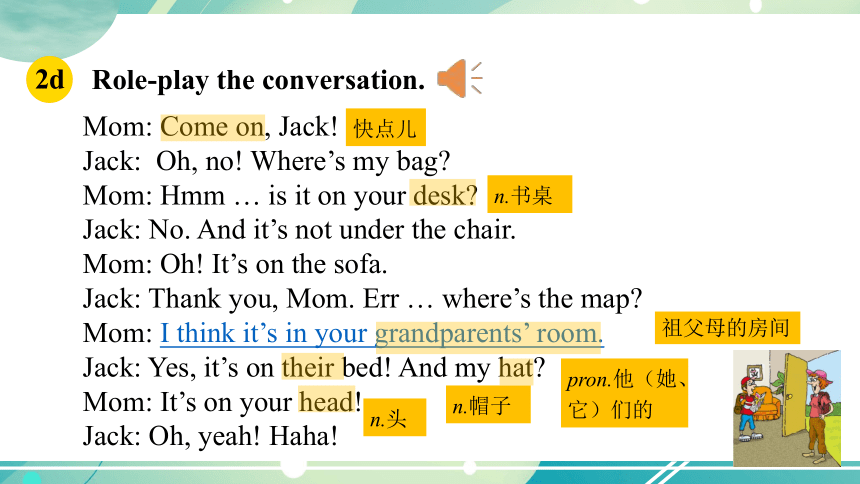

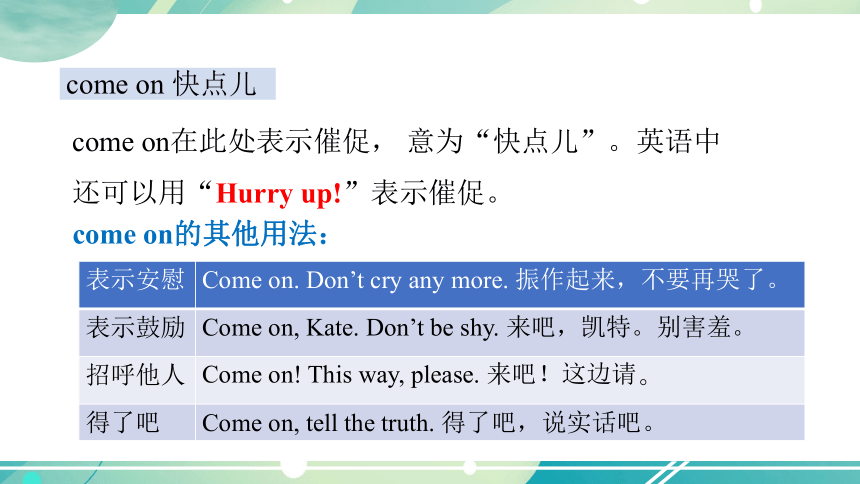
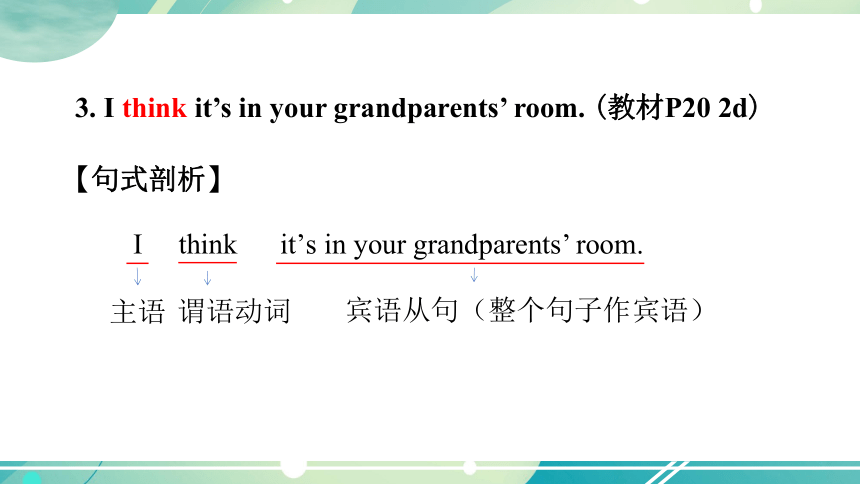
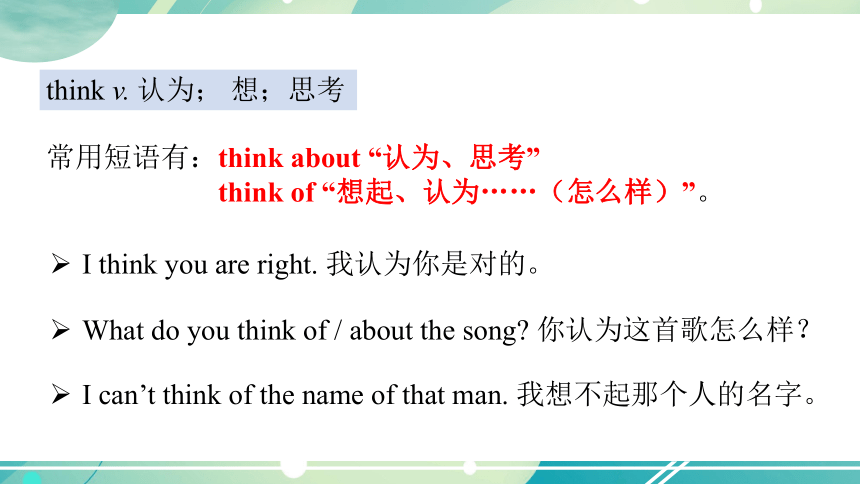
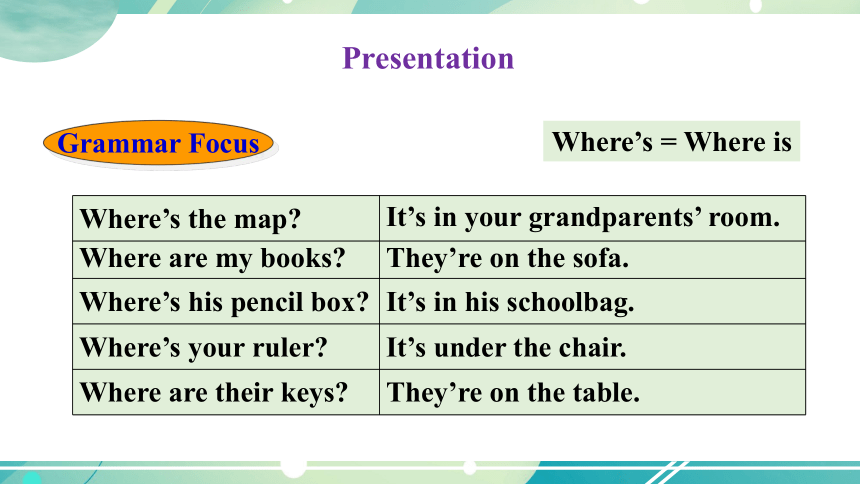
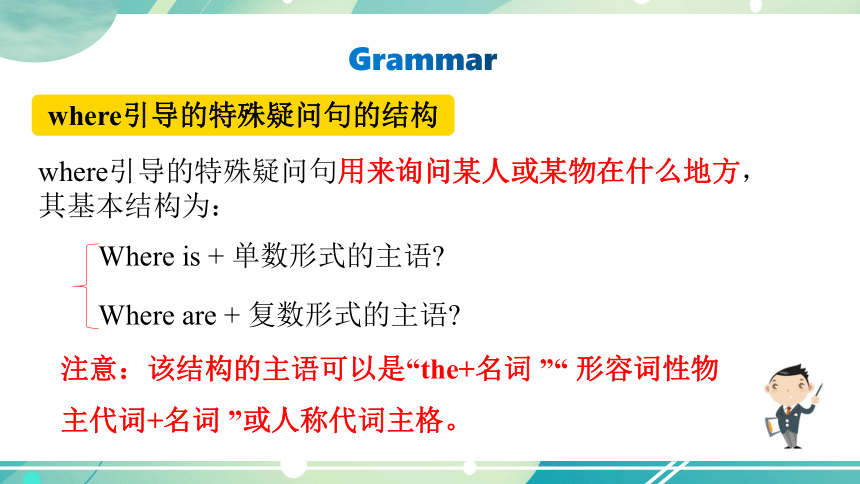
文档简介
(共30张PPT)
Unit 4 Where’s my schoolbag
Section A (2d-3b)
Key words & phrases:
know, I don’t know, on the right, find the differences
Key sentences:
1. —Where’s the map —It’s in your grandparents’ room.
2.—Where are my books —They’re on the sofa.
3. —Where’s his pencil box —It’s in his schoolbag.
4. —Where’s your ruler —It’s under the chair.
5.—Where are their keys —They’re on the table.
To learn to use prepositions of place and where questions.
学习目标
Let’s review!
1.我的书包在哪里?
2.它在椅子下。
3.我的书(复数)在哪里?
4.他们在沙发上。
5.你的钥匙(复数)在书包里吗?
Where is my schoolbag
It’s under the chair.
Are your keys in the schoolbag
Where are my books
They are on the sofa.
Warming up
Where’s the ball
It’s on the box.
It’s under the box.
It’s in the box.
A: Where’s the…
B: It’s in / on / under /…
A: Where are the…
B: They’re in / on / under /…
2d
Role-play the conversation.
Mom: Come on, Jack!
Jack: Oh, no! Where’s my bag
Mom: Hmm … is it on your desk
Jack: No. And it’s not under the chair.
Mom: Oh! It’s on the sofa.
Jack: Thank you, Mom. Err … where’s the map
Mom: I think it’s in your grandparents’ room.
Jack: Yes, it’s on their bed! And my hat
Mom: It’s on your head!
Jack: Oh, yeah! Haha!
祖父母的房间
pron.他(她、它)们的
n.书桌
快点儿
n.帽子
n.头
2. Come on, Jack! (教材P20 2d)
come是不及物动词,其反义词为go,意为“去”。come常与介词to搭配使用, 后面跟地点名词,表示“来到某地”。当come后跟here,home等地点副词时,其后不带介词to。
The train comes to the station. 火车进站了。
come v.来;来到
My mother always comes home at 6:00. 我妈妈总是在6点回到家。
come on 快点儿
come on在此处表示催促, 意为“快点儿”。英语中还可以用“Hurry up!”表示催促。
come on的其他用法:
表示安慰 Come on. Don’t cry any more. 振作起来,不要再哭了。
表示鼓励 Come on, Kate. Don’t be shy. 来吧,凯特。别害羞。
招呼他人 Come on! This way, please. 来吧!这边请。
得了吧 Come on, tell the truth. 得了吧,说实话吧。
3. I think it’s in your grandparents’ room. (教材P20 2d)
【句式剖析】
I think it’s in your grandparents’ room.
主语
谓语动词
宾语从句(整个句子作宾语)
常用短语有:think about “认为、思考”
think of “想起、认为……(怎么样)”。
I think you are right. 我认为你是对的。
think v. 认为; 想;思考
What do you think of / about the song 你认为这首歌怎么样?
I can’t think of the name of that man. 我想不起那个人的名字。
Presentation
Grammar Focus
Where’s the map It’s in your grandparents’ room.
Where are my books They’re on the sofa.
Where’s his pencil box It’s in his schoolbag.
Where’s your ruler It’s under the chair.
Where are their keys They’re on the table.
Where’s = Where is
Grammar
where引导的特殊疑问句的结构
where引导的特殊疑问句用来询问某人或某物在什么地方,其基本结构为:
Where are + 复数形式的主语
注意:该结构的主语可以是“the+名词 ”“ 形容词性物主代词+名词 ”或人称代词主格。
Where is + 单数形式的主语
Where are my books 我的书在哪里?
Where is the bag 包在哪里?
Where are they 他们在哪里?
Where is 可缩写为 where’s; 但是where are 不能缩写。
where引导的特殊疑问句的回答
where引导的特殊疑问句不可以用yes或no回答,常用一个完整的句子,即“主语 + be动词 + 介词短语 + 其他.” 。但要注意以下几点:
1) 为避免重复,回答时主语常用相应的人称代词代替。
—Where is the bag 包在哪里?
—It’s on the desk. 它在书桌上。
(用It指代the bag)
2)非正式场合也可省略主语和be动词,直接用介词短语回答。
—Where are my books 我的书在哪里?
—In the classroom. 在教室里。
3)如果不知道某人或某物在什么地方, 可以说“Sorry, I don’t
know.”。
—Where are they 他们在哪里?
—Sorry, I don’t know. 对不起,我不知道。
方位介词on / in / under
英语中,方位介词不能单独使用,一般用于名词或代词前。
语法概述
方位介词on / in / under的用法
on 在......上 一个物体在另一个物体的表面上,且两个物体之间有接触。
in 在......里 一个物体在另一个物体或某一空间的内部。
under 在......下 一个物体在另一个物体的正下方,两者可以接触,也可以不接触。
My watch is on the table. 我的手表在桌子上。
They are in the room. 他们在房间里。
The basketball is under the chair. 篮球在椅子下面。
3a
Look at the pictures and complete the conversations.
A: Where ______ the keys
B: They’re ______ the ________.
are
on
table
1
A: Where’s the _______ _____ it on your desk
B: No, it’s _______ the chair.
book
Is
under
2
3
A: Where _______ the pencils
B: I don’t know. ______ they in the __________
A: Yes, they are.
are
Are
schoolbag
我不知道。
3b
Ask and answer questions about the things on the right.
A: Where are my books
B: I don’t know. Are they on the sofa
A: Yes, they are.
A: Where’s the computer game
B: I think it’s in the bookcase.
A: Yes, you are right. And the books
are in the bookcase, too.
A: Where are the pencils
Are they under the chair
B: No, they aren’t. They’re in the pencil box.
3c
Student A, look at the picture on Page 19. Student B, look at the picture on the right. Ask and answer questions to find the differences.
A: Where’s the schoolbag
Is it under the table
B: No, it isn’t. It’s on the table.
On page 21:
The books are on the bed, not in the schoolbag.
The CD is in the schoolbag, not under the bed.
The computer game is under the bed, not on the table.
The pencil box is on the table, not in the schoolbag.
…
Exercises
补全对话,每空一词。
1. —Where ______ my computer game
— ______ ______ on the table.
2. —Where ______ your books
— ______ ______ in my schoolbag.
3. —______ Kate in the room
—Yes, ______ ______.
is
It is
are
They are
Is
she is
1. —_________ is the computer game
—It’s on the desk.
2. —What’s her name
—Sorry, I don’t _________.
3. —Are your keys in your parents’ room
—Yes, they are on _________ bed.
4. Look! The baseball is _________ the chair.
5. My books are in the ___________.
选词填空
their where under bookcase know
Where
know
their
under
bookcase
1. _______ _______ my books
我的书在哪里?
2. _________ ______ pencil box
他的铅笔盒在哪里?
3. My pen isn’t _____ the schoolbag. It’s _____ the sofa.
我的钢笔不在书包里。它在沙发上。
Where are
Where’s his
in
on
完成句子,每空一词。
Homework
Preview the new words and phrases in Section B (1a-1e).
Do the exercises in students’ book.
Unit 4 Where’s my schoolbag
Section A (2d-3b)
Key words & phrases:
know, I don’t know, on the right, find the differences
Key sentences:
1. —Where’s the map —It’s in your grandparents’ room.
2.—Where are my books —They’re on the sofa.
3. —Where’s his pencil box —It’s in his schoolbag.
4. —Where’s your ruler —It’s under the chair.
5.—Where are their keys —They’re on the table.
To learn to use prepositions of place and where questions.
学习目标
Let’s review!
1.我的书包在哪里?
2.它在椅子下。
3.我的书(复数)在哪里?
4.他们在沙发上。
5.你的钥匙(复数)在书包里吗?
Where is my schoolbag
It’s under the chair.
Are your keys in the schoolbag
Where are my books
They are on the sofa.
Warming up
Where’s the ball
It’s on the box.
It’s under the box.
It’s in the box.
A: Where’s the…
B: It’s in / on / under /…
A: Where are the…
B: They’re in / on / under /…
2d
Role-play the conversation.
Mom: Come on, Jack!
Jack: Oh, no! Where’s my bag
Mom: Hmm … is it on your desk
Jack: No. And it’s not under the chair.
Mom: Oh! It’s on the sofa.
Jack: Thank you, Mom. Err … where’s the map
Mom: I think it’s in your grandparents’ room.
Jack: Yes, it’s on their bed! And my hat
Mom: It’s on your head!
Jack: Oh, yeah! Haha!
祖父母的房间
pron.他(她、它)们的
n.书桌
快点儿
n.帽子
n.头
2. Come on, Jack! (教材P20 2d)
come是不及物动词,其反义词为go,意为“去”。come常与介词to搭配使用, 后面跟地点名词,表示“来到某地”。当come后跟here,home等地点副词时,其后不带介词to。
The train comes to the station. 火车进站了。
come v.来;来到
My mother always comes home at 6:00. 我妈妈总是在6点回到家。
come on 快点儿
come on在此处表示催促, 意为“快点儿”。英语中还可以用“Hurry up!”表示催促。
come on的其他用法:
表示安慰 Come on. Don’t cry any more. 振作起来,不要再哭了。
表示鼓励 Come on, Kate. Don’t be shy. 来吧,凯特。别害羞。
招呼他人 Come on! This way, please. 来吧!这边请。
得了吧 Come on, tell the truth. 得了吧,说实话吧。
3. I think it’s in your grandparents’ room. (教材P20 2d)
【句式剖析】
I think it’s in your grandparents’ room.
主语
谓语动词
宾语从句(整个句子作宾语)
常用短语有:think about “认为、思考”
think of “想起、认为……(怎么样)”。
I think you are right. 我认为你是对的。
think v. 认为; 想;思考
What do you think of / about the song 你认为这首歌怎么样?
I can’t think of the name of that man. 我想不起那个人的名字。
Presentation
Grammar Focus
Where’s the map It’s in your grandparents’ room.
Where are my books They’re on the sofa.
Where’s his pencil box It’s in his schoolbag.
Where’s your ruler It’s under the chair.
Where are their keys They’re on the table.
Where’s = Where is
Grammar
where引导的特殊疑问句的结构
where引导的特殊疑问句用来询问某人或某物在什么地方,其基本结构为:
Where are + 复数形式的主语
注意:该结构的主语可以是“the+名词 ”“ 形容词性物主代词+名词 ”或人称代词主格。
Where is + 单数形式的主语
Where are my books 我的书在哪里?
Where is the bag 包在哪里?
Where are they 他们在哪里?
Where is 可缩写为 where’s; 但是where are 不能缩写。
where引导的特殊疑问句的回答
where引导的特殊疑问句不可以用yes或no回答,常用一个完整的句子,即“主语 + be动词 + 介词短语 + 其他.” 。但要注意以下几点:
1) 为避免重复,回答时主语常用相应的人称代词代替。
—Where is the bag 包在哪里?
—It’s on the desk. 它在书桌上。
(用It指代the bag)
2)非正式场合也可省略主语和be动词,直接用介词短语回答。
—Where are my books 我的书在哪里?
—In the classroom. 在教室里。
3)如果不知道某人或某物在什么地方, 可以说“Sorry, I don’t
know.”。
—Where are they 他们在哪里?
—Sorry, I don’t know. 对不起,我不知道。
方位介词on / in / under
英语中,方位介词不能单独使用,一般用于名词或代词前。
语法概述
方位介词on / in / under的用法
on 在......上 一个物体在另一个物体的表面上,且两个物体之间有接触。
in 在......里 一个物体在另一个物体或某一空间的内部。
under 在......下 一个物体在另一个物体的正下方,两者可以接触,也可以不接触。
My watch is on the table. 我的手表在桌子上。
They are in the room. 他们在房间里。
The basketball is under the chair. 篮球在椅子下面。
3a
Look at the pictures and complete the conversations.
A: Where ______ the keys
B: They’re ______ the ________.
are
on
table
1
A: Where’s the _______ _____ it on your desk
B: No, it’s _______ the chair.
book
Is
under
2
3
A: Where _______ the pencils
B: I don’t know. ______ they in the __________
A: Yes, they are.
are
Are
schoolbag
我不知道。
3b
Ask and answer questions about the things on the right.
A: Where are my books
B: I don’t know. Are they on the sofa
A: Yes, they are.
A: Where’s the computer game
B: I think it’s in the bookcase.
A: Yes, you are right. And the books
are in the bookcase, too.
A: Where are the pencils
Are they under the chair
B: No, they aren’t. They’re in the pencil box.
3c
Student A, look at the picture on Page 19. Student B, look at the picture on the right. Ask and answer questions to find the differences.
A: Where’s the schoolbag
Is it under the table
B: No, it isn’t. It’s on the table.
On page 21:
The books are on the bed, not in the schoolbag.
The CD is in the schoolbag, not under the bed.
The computer game is under the bed, not on the table.
The pencil box is on the table, not in the schoolbag.
…
Exercises
补全对话,每空一词。
1. —Where ______ my computer game
— ______ ______ on the table.
2. —Where ______ your books
— ______ ______ in my schoolbag.
3. —______ Kate in the room
—Yes, ______ ______.
is
It is
are
They are
Is
she is
1. —_________ is the computer game
—It’s on the desk.
2. —What’s her name
—Sorry, I don’t _________.
3. —Are your keys in your parents’ room
—Yes, they are on _________ bed.
4. Look! The baseball is _________ the chair.
5. My books are in the ___________.
选词填空
their where under bookcase know
Where
know
their
under
bookcase
1. _______ _______ my books
我的书在哪里?
2. _________ ______ pencil box
他的铅笔盒在哪里?
3. My pen isn’t _____ the schoolbag. It’s _____ the sofa.
我的钢笔不在书包里。它在沙发上。
Where are
Where’s his
in
on
完成句子,每空一词。
Homework
Preview the new words and phrases in Section B (1a-1e).
Do the exercises in students’ book.
同课章节目录
- starters 预备篇(2012秋审查)
- Unit 1 Good morning !
- Unit 2 What’s this in English?
- Unit 3 What color is it ?
- Unit 1 My name's Gina.
- Section A
- Section B
- Unit 2 This is my sister.
- Section A
- Section B
- Unit 3 Is this your pencil?
- Section A
- Section B
- Unit 4 Where's my schoolbag?
- Section A
- Section B
- Unit 5 Do you have a soccer ball?
- Section A
- Section B
- Unit 6 Do you like bananas?
- Section A
- Section B
- Unit 7 How much are these socks?
- Section A
- Section B
- Unit 8 When is your birthday?
- Section A
- Section B
- Unit 9 My favorite subject is science.
- Section A
- Section B
